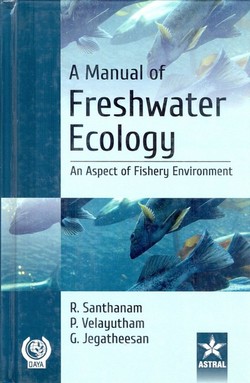
A Manual of Freshwater Ecology
An Aspect of Fishery Environment
By
R. Santhanam & P. Velayutham and G. Jegatheesan
Preface
A number of foreign publications are available now-a-days on various aspects of Ecology and in particular limnology. However, a comprehensive publication dealing with all methods of studying freshwater bodies with special reference to India is still wanting. The present publication satisfies this long felt gap.
The contents of this book include a number of methods on the physico-chemical and biological characteristics of freshwater ecology which are dealt with in detail under three headings viz., water analysis, soil analysis and biological analysis. We have tried to present all these methods in an easy-to-read style with illustrations wherever required. It is hoped that this will not only serve as a manual for all students who have fisheries environment, limnology or aquatic biology in their curricula, but also for people in other fields, where elementary aspects of freshwaters are relevant.
The word 'Ecology' was first described as a separate discipline in 1866 by the German Zoologist Ernst Haeckel and this multidisciplinary science had its origin from the Greek words 'Oikos' meaning habitation and 'logos' meaning the study of habitations of plants and animals. It can be defined broadly as the study of interrelations between organisms and their environment. The study of ecology has now diverged into a number of paths of which, ecosystem ecology, population ecology, evolutionary ecology, behavioural ecology, chemical ecology and physiological ecology are getting increasing attention.
Among the different aspects of ecology, the study of hydrology encompassing chiefly limnology and oceanology has assumed greater significance in recent years as it is concerned with the environmental problems of today. While limnology deals with inland waters, the science of oceanology is concerned with marine ecosystems. Although limnology relates to stationery water bodies, flowing waters and underground waters of inland areas, freshwaters as constituents of inland waters are considered to be dynamic systems in which the living plants and animals not only interact but also influence the habitat profoundly. Applied ecology also plays a vital role in human life now-a-days as it is concerned with making recommendations to mitigate or eliminate environmental damage.
In order to understand the fertility of any freshwater system for its possible use in culture or capture fisheries, a study on its physico-
chemical and biological characteristics and soil is indispensable.
Contents
I – Water Analysis
1 – Light penetration
2 – Velocity of running waters
3 – Collection and preservation of water samples
4 – Oxygen
5 – Carbon dioxide
6 – Acidity
7 – Alkalinity
8 – Hardness
9 – Chlorine
10 – Chloride
11 – Sulphate
12 – Nitrogen
13 – Nitrite
14 – Nitrate
15 – Ammonia
16 – Phosphate
17 - Total phosphorus
18 – Silica
19 - Hydrogen sulphide
20 - Total solids
21 - Biochemical oxygen demand
22 - Chemical oxygen demand
23 – Carbohydrates
24 – Chlorophylls
II - Soil Analysis
1 – Moisture
2 – pH
3 - Bulk density
4 - Specific gravity
5 – Alkalinity
6 – Chloride
7 – Nitrate
8 – Sulphate
9 - Total phosphorus
10 - Organic matter
III - Biological Analysis
1 – Identification of micro and macrophytes
2 – Collection and preservation of plankton
3 – Estimation of plankton biomass
4 – Collection and analysis of periphyton
5 – Estimation of primary production
6 – Estimation of secondary production
7 – Collection and analysis of benthos
8 – Determination of energy content
9 – Population and community studies



ساحة النقاش